 | ||
Simmering is a food preparation technique in which foods are cooked in hot liquids kept just below the boiling point of water (which is 100 °C or 212 °F at average sea level air pressure), but higher than poaching temperature. To keep a pot simmering, one brings it to a boil and then reduces the heat to a point where the formation of bubbles has almost ceased, typically a water temperature of about 94 °C (200 °F) at sea level.
Contents
In food preparation
Simmering ensures gentler treatment than boiling to prevent food from toughening and/or breaking up. Simmering is usually a rapid and efficient method of cooking. Food that has simmered in milk or cream instead of water is sometimes referred to as creamed. The appropriate simmering temperature is a topic of debate among chefs, with some contending that a simmer is as low as 82 °C (180 °F).
Japanese cuisine
In Japanese cuisine, simmering is considered one of the four essential cooking techniques.
American cuisine
Food prepared in a crockpot is simmered. Examples include stews, chili, soups, etc.
Bulgarian cuisine
Bulgarian traditional food, especially tender meat dishes are often simmered for extended periods of time. Examples include stews, soups, Vanyas, etc.
Dutch and Flemish cuisine
In traditional Dutch and Flemish cuisine, less tender cuts of beef are simmered for several hours to obtain Carbonade flamande. Traditionally a small flame is used, fed by burning oil. On modern stoves, the source of heat is put very low, or a simmering plate is used to diminish the heat. Usually a cast iron pan is used with a thick bottom. The meat is ready if it can be easily torn apart into threads.
Modern stoves
Some modern gas ranges are equipped with a simmering burner, with such burners usually located at the rear of the range. Many electric ranges have a simmer setting.
